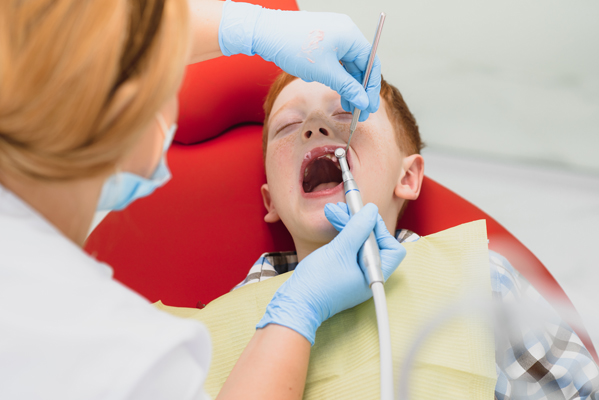Effective Cavity Treatment for Kids: What You Should Know

Cavity treatment for kids can help children maintain their long-term oral health. Tooth decay in children can lead to discomfort, infection, and long-term dental complications if left untreated. Fortunately, early detection and appropriate pediatric dental care can prevent complications and support healthy oral development as children grow up.
How cavities form in young teeth
Cavities develop when bacteria in the mouth feed on sugars and starches from food and beverages, producing acid that gradually erodes tooth enamel. In children, several factors contribute to the risk of cavities, including:
- Naturally weak enamel
- Overconsumption of sugary or acidic foods
- Poor oral hygiene habits
- Lack of fluoride in their diet
- Prolonged bottle-feeding or sippy cup use
- Certain medications
- Frequent snacking, poor oral hygiene, lack of fluoride in their diet, and prolonged bottle-feeding or sippy cup use
Additionally, baby teeth are thinner and less mineralized than adult teeth, making them more susceptible to decay. Early signs of cavities in children may include sensitivity to cold or sweet foods, visible pits or discoloration on teeth, or complaints of tooth pain. Regular dental check-ups can detect the early signs of tooth decay and provide prompt intervention.
Common types of cavity treatment for kids
When a dentist diagnoses a cavity, the appropriate treatment will depend on the size, location, and severity of the damage. There are several types of cavity treatment for kids, each designed to restore the tooth and prevent further damage.
Fluoride treatments
For minor tooth decay, professional fluoride treatment can help remineralize enamel and protect the tooth from further damage. These treatments are usually applied during routine dental visits. Professional flouride treatments are especially effective when the dentist catches decay in its earliest stages.
Dental fillings
The most common way to treat mild to moderate cavities is to remove the decayed part of the tooth and place a filling. For children, the pediatric dentist will usually use tooth-colored composite resin,as the material looks natural and compability with primary teeth. Fillings help the tooth function properly and protect it from more decay.
Dental crowns
When a cavity is large or damages a large part of the tooth, the child may need a dental crown. Pediatric dentists often use pre-made stainless steel crowns for children because they are durable and can be removed once the primary tooth falls out. Crowns help restore the tooth's shape and structure, providing long-lasting protection.
Baby root canal
If decay has reached the inner pulp of the tooth, a pulpotomy or pulpectomy — also known as a baby root canal — may be necessary to remove the infected tissue. This type of cavity treatment for kids helps preserve the tooth and prevent the need for extraction. The procedure is followed by the placement of a crown to seal and protect the treated tooth.
Tooth extractions
In cases where a tooth is severely decayed and cannot be restored, extraction may be used as a last resort. The pediatric dentist may recommend a space maintainer to ensure that surrounding teeth do not shift, preserving the space necessary for the permanent tooth.
Preventive treatments to support cavity-free teeth
While these cavity treatment options are effective, prevention remains the best strategy. As the saying goes, prevention is better than the cure. When parents help their children establish a strong oral care routine from an early age, it can greatly reduce the risk of cavities.
The following preventive measures can protect the young patient's teeth from further damage:
- Brushing and flossing: Children should brush their teeth twice daily with fluoride toothpaste and floss once a day to remove plaque and food particles from the surface and in between their teeth.
- Healthy diet: Limiting the consumption of sugary snacks and beverages can reduce the prevalence of cavity-causing bacteria.
- Regular dental visits: Routine check-ups every six months enable early detection and allow for preventive treatments such as fluoride applications and sealants.
- Dental sealants: Sealants are protective coatings applied to the chewing surfaces of the child's molars. They act as a barrier against plaque and food, reducing the risk of cavities in these hard-to-reach areas.
While not all cavities are preventable, following these measures can protect the young patient's teeth from further decay and lower the risk of extensive damage.
Schedule your child's next appointment at our Houston office
Cavity treatment for kids is essential to pediatric dental care, ensuring young patients have bright and healthy smiles as they grow and develop. Is your child due for a dental visit? Call our Houston office to schedule their next appointment.
Request an appointment here: https://www.memorialpediatricdds.com or call Memorial Pediatric Dentistry at (281) 822-6600 for an appointment in our Houston office.
Check out what others are saying about our dental services on Yelp: Pediatric Dentist in Houston, TX.
Recent Posts
There are certain questions that are important to ask your child’s pediatric dentist to find out about their skill, experience and ability to keep your child comfortable while at the dentist. By learning more about your child’s pediatric dentist, you can calm any anxieties you or your child have before a visit. Every pediatric dentist asks…
According to the American Academy of Pediatric Dentistry, parents should take their children for their first visit to the pediatric dentist by the time they clock one. The dental appointments early in life are crucial for ensuring healthy teeth and proper oral development. It also allows the child to get acquainted with the pediatric dentist…
From the first appointment, a Pediatric Dentist keeps in mind a pacifier or thumb sucking habit and watches the way your child's teeth and jaw develop. According to the American Academy of Pediatric Dentistry, sucking generally only becomes a problem if it continues after the age of 3. It is normal for children to suck on…
Your child needs pediatric dentistry services. Caring for their mouth, teeth and gums is critical at a young age. You work hard to keep cavities, plaque, tartar and other issues at bay. If you place a significant emphasis on your health, you should do the same for your young family members. If your child needs…


